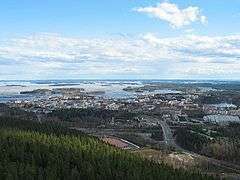Blue Highway (tourist route)
| Blue Highway | |
|---|---|
| Route information | |
| Length: | 1,800 km (1,100 mi) |
| Major junctions | |
| Northwest end: | Mo i Rana |
| East end: | Pudozh |
| Location | |
| Countries: | Norway, Sweden, Finland, Russia |
| Major cities: | Mo i Rana, Storuman, Lycksele, Umeå, Vaasa, Lapua, Viitasaari, Kuopio, Joensuu, Tohmajärvi, Pryazha, Petrozavodsk |
| Highway system | |
| Transport in Europe | |
Blue Highway (Norwegian: Blå vegen, Swedish: Blå vägen, Finnish: Sininen tie, Russian: Голубая дорога) is an international tourist route from Norway via Sweden and Finland to Russia.[1][2]
Sights
The Blue Highway follows the ancient waterways from the Atlantic Ocean to Lake Onega. There are numerous lakes and rivers by the road. Vast areas of taiga forest dominate the landscape,[3] and a section of the Scandinavian Mountains in Norway and western Sweden.
There are rural villages as well as cities and towns by the Blue Highway.
| Country | Region | Sight |
|---|---|---|
Norway |
Nordland |
Atlantic Ocean Mo i Rana, a town near the Arctic Circle Svartisen, the second largest glacier on the Norwegian mainland |
Västerbotten County |
Storuman, with ski resorts (Hemavan, Tärnaby), the Alpine Botanical Garden (in Hemavan), Vindelfjällen Nature Centre (in Hemavan), Stensele Church (the largest wooden church in Sweden)[4] The Museum of Forestry, in Lycksele[5][6] Lycksele Zoo, the northernmost zoological garden in Sweden Umeå, capital of Västerbotten County on the Ume River | |
Finland |
Ostrobothnia |
Vaasa, capital of Ostrobothnia Kvarken, Unesco World Heritage Site[7] Replot Bridge, the longest bridge of Finland |
Finland |
Southern Ostrobothnia |
Alajärvi, architect Alvar Aalto's first and last public buildings[8] |
Finland |
Central Finland |
Huopanankoski, one of the oldest fishing rapids in Finland with cultural heritage landscape, located in Viitasaari |
Finland |
Northern Savonia |
Lakeland, networks of thousands of lakes separated by hilly forested countryside Lepikon torppa in Pielavesi, a birthplace of Urho Kekkonen, a former President of Finland[9] Kolu Channel in Tervo, the longest inland water channel in Finland[10] Korkeakoski, the longest waterfall in Finland, located in Maaninka Kuopio, the capital of Northern Savonia by the Kallavesi Lake Puijo, recreation area, skijumping hill, tower Tahkovuori, tourist centre by the Lake Syväri Ohtaansalmi, Treaty of Teusina boundary mark by the Rikkavesi Lake[11] |
Finland |
North Karelia |
Lakeland, networks of thousands of lakes separated by hilly forested countryside Outokumpu, mine museum with tunnel, train and tower[12] Joensuu, capital of North Karelia on the Pielisjoki River Pyhäselkä Lake, the northernmost part of the Saimaa lake system |
Russia |
Republic of Karelia |
Lake Ladoga, the largest lake in Europe Valaam, monastery in Valaam archipelago Petrozavodsk, capital of Republic of Karelia Kizhi, Unesco World Heritage Site[13] Lake Onega, the second largest lake in Europe Kondopoga, Martsialnye vody (Marcial Spa) - the oldest Russian spa, Kivach Nature Reserve Medvezhyegorsk, i.a. military history tourist attractions, Sandarmokh - the site of mass shootings and burials of victims of Soviet political repressions, White Sea – Baltic Sea Canal ("the Stalin Canal") Pudozh, Vodlozersky National Park and Onega petroglyphs (rock engravings) |
The Development of the Blue Highway
- The idea of a road across Northern Europe was born in the 1950s
- The Blue Highway Association was formed in Sweden in 1963
- Year-round ferry service between Umeå and Vaasa in 1972
- The Blue Highway becomes a European Highway in 1973
- Public transport between Umeå and Mo i Rana in 1989
- Border crossing (Niirala/Vyartsilya) with Russia was opened in 1990
- The Blue Road Highway extended to Pudozh, Russia, in 2000[3]
Gallery
See also
References
- ↑ "Blue Highway". Retrieved January 3, 2015.
- ↑ "Finnish Travel Routes" (PDF). Autoliitto (Automobile and Touring Club of Finland). Retrieved January 3, 2015.
- 1 2 Sights in Västerbotten/Sweden, The Blue Highway, pdf, 2008, Västerbotten Local Folklore Society and The Museum of Västerbotten, January 9, 2015
- ↑ Storuman - Tourist Information
- ↑ Municipality of Lycksele: Forestry Museum Archived January 18, 2015, at the Wayback Machine.
- ↑ Skogsmuseet (The Museum of Forestry)
- ↑ World Heritage List: High Coast / Kvarken Archipelago
- ↑ Alajärvi; Architect Alvar Aalto
- ↑ Lepikon torppa (in Finnish)
- ↑ Municipality of Tervo
- ↑ Municipality of Tuusniemi: Boundary marks of the Peace Treaty of Teusina
- ↑ Aarrekaupunki Outokumpu: Outokummun kaivosmuseo (Outokumpu Mine Museum) Archived January 17, 2015, at the Wayback Machine.
- ↑ World Heritage List: Kizhi Pogost
External links
- Blue Highway in Sweden (English)
- Finnish Travel Routes (English, Russian, Swedish, Finnish)
- Blue Highway in Finland (Finnish)
This article is issued from Wikipedia - version of the 11/19/2016. The text is available under the Creative Commons Attribution/Share Alike but additional terms may apply for the media files.





